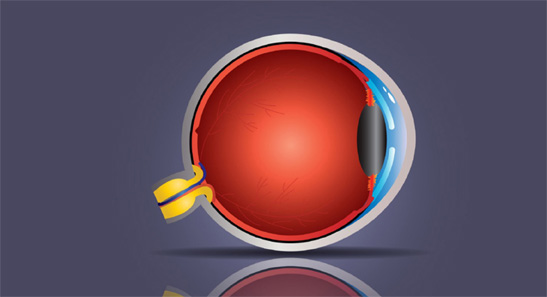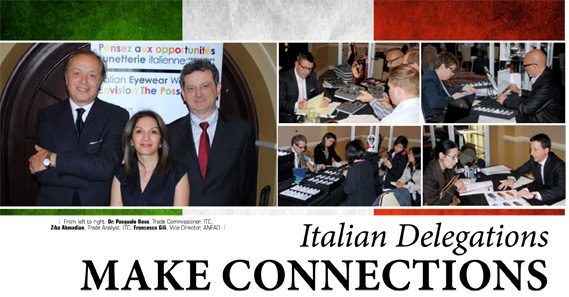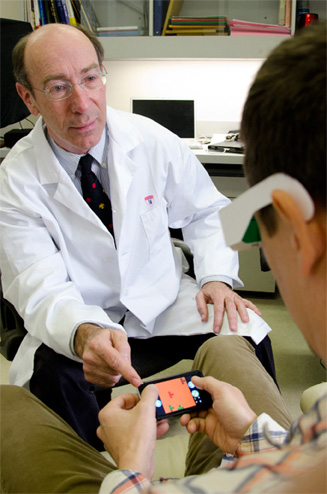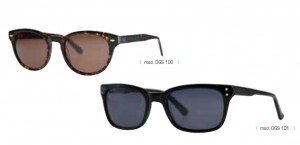By JoAnne Sommers
 These days, it’s impossible to escape blue light. TVs, computers, smartphones, tablets and e-readers bombard our eyes with blue light emissions day and night.
These days, it’s impossible to escape blue light. TVs, computers, smartphones, tablets and e-readers bombard our eyes with blue light emissions day and night.
Electronic devices aren’t the only culprits. Energy-saving light bulbs (notably LEDs) may be “green” but they also emit a significant proportion of blue light (also known as High-Energy Visible [HEV] light). While present in natural light, blue light occurs in abnormal proportions in artificial light sources.
Blue/HEV light covers wavelengths from 380 to 500 nanometers (nm). Although the eyes’ natural filters block UV light, they do not block blue/HEV light, meaning it is able to pass through the cornea, the crystalline lens and the vitreous and potentially damage the retina. HEV light is toxic for the crystalline lens and retina which can lead to retinal cell death and early cataract formation.
Now, multiple lens manufacturers have developed new products designed to address the dangers posed by blue light.
Dr. Francine Behar-Cohen is founder of the INSERM (French Institute of Health and Medical Research) 598 Unit, which is dedicated to the physiopathology of ocular illness. She says that HEV light has long been identified as the most dangerous light for the retina. “After chronic exposure, one can expect… (long term)… growth of macular degenerations, glaucomas and retinal degenerative diseases.”
There is also a growing body of evidence that cumulative lifetime exposure to blue wavelength light increases the risk of age-related macular degeneration (AMD). According to Alexander Wunsch, a German photobiologist and physician, energy-saving lamps, and more generally fluorescent lamps, emit light containing an excessively significant proportion of short wavelengths.
“Chronic exposure to a short-wavelength light highly contributes to macular degeneration,” he says.
Blue light, which scatters easily, can also reduce contrast and add to eye fatigue, or digital eyestrain, which is now the number one computer-related complaint in the U.S.
Nor is digital eyestrain limited to adults or the workplace. Because of their growing use of digital devices, children are also at risk.
The problems don’t end there. Evidence is mounting that exposure to blue light may lead to a whole host of other concerns. The Harvard Medical School’s Harvard Health Letter says that at night, light disrupts the body’s biological clock – the circadian rhythm – resulting in sleep problems. Research shows that it may also contribute to the causation of cancer, diabetes, heart disease and obesity.
“Blue wavelengths – which are beneficial during daylight hours because they boost attention, reaction times and mood – seem to be the most disruptive at night,” says the Letter. “And the proliferation of electronics with screens, as well as energy-efficient lighting, is increasing our exposure to blue wavelengths, especially after sundown.”
Such an aggressive visual environment calls for special lens products and several companies have responded accordingly.
In 2012, Nikon introduced SeeCoat Blue to the Canadian market. It was the first in a new category of functional anti-reflective (AR) coatings that reduce blue light, while enhancing contrast and helping to reduce digital eyestrain, says Tibor Martz, director of Nikon’s Technical Assistance Groups.
“We wanted to eliminate a portion of the harmful blue light with a product that, unlike a sunglass, can be used indoors,” he explains.
SeeCoat Blue is a lens coating specifically designed to filter HEV light, as opposed to a tint, adds Martz. On the front and back of the lens the AR is applied in such a way that it effectively eliminates a portion of blue light in the 380-500 nm range. The amount of blue light that is blocked varies, depending on the intensity of blue light present.
According to the ISO (International Organization for Standardization), blue light hazard function peaks at 435 to 440 nm, while LEDs peak at 440 to 455 nm.
SeeCoat Blue effectively improves contrast and reduces ocular stress, says Martz, while combining all the benefits of the latest coatings: scratch-resistance, anti-glare, dust elimination and antistatic properties. It also reduces the proportion of HEV light reaching the retina in order to protect visual health.
SeeCoat Blue is available on all Nikon Rx lenses that are also available with SeeCoat Plus.
The market for SeeCoat Blue is wide open, says Martz. “It includes kids who play video games, as well as both eyeglass wearers and non-wearers,” he says. “It’s largely untapped, much like the market for sunscreen in an earlier era.”
Essilor’s Crizal Prevencia™ is a clear lens that features selective photo-protection. Selective AR technology filters out harmful UV and blue-violet light while allowing essential light, including blue light, to pass through, and ensuring excellent transparency.
The lens, which will be launched in September, provides the best protection against UV and blue light, says Sakina Barrault, Essilor Canada’s senior brand manager.
“Crizal Prevencia is unique in that it only blocks the blue-violet light (415-455 nm) that damages retinal cells, while letting essential light, including blue-turquoise, pass through,” she explains.
Blue-turquoise light, which is in the 465 to 495 nm range, aids the pupillary constriction reflex and activates melatonin, which regulates mood, cognitive function and memory.
“Crizal Prevencia blocks twice as much blue-violet light as its competitors while allowing good colour perception and vision and keeping the lens transparent,” says Barrault. “Essilor has done tests with the Paris Institute of Vision which show that those who used Crizal Prevencia had a 25 per cent decrease in the death of retinal cells. At that rate, it could alleviate the cumulative risk of AMD.”
By blocking blue-violet light, the lens improves contrast and alleviates eye fatigue, adds Barrault. “It also benefits from the UV protection of Crizal lenses, giving you clarity of vision, while it eliminates glare, scratches, smudges, dust and water.”
The AR layer on the backside of the lens features Broad Spectrum technology, which virtually eliminates UV rays reflected into the eye from that location, she adds. “Ours are the only lenses with backside protection, which means they provide complete UV protection.”
Crizal Prevencia has the same availability as Crizal Forte lenses.
“It’s designed for adults, especially those over 45, who are more prone to cataracts and AMD than younger adults, as well as children, whose eyes allow in six times as much radiation as adult eyes,” says Barrault. “AMD results from a cumulative effect so the sooner you start to reduce risk, the better.”
HOYA’s Recharge™ is an anti-reflective lens treatment that reflects harmful blue light away from the eyes, while ensuring that the portion of blue light needed for optimal contrast and other health benefits is allowed to pass through the lens.
“Recharge reduces blue light by about 30 per cent in the HEV light range (380 to 500 nm),” says Maria Petruccelli, director of the professional business division, HOYA Vision Care Canada. “It increases contrast and visual sharpness, reduces glare, and provides a measure of protection from blue light risks. It also provides HOYA AR quality on physical attributes, including adhesion, scratch resistance, longevity and cleanability.”
Because Recharge helps to protect against the accumulated potential harmful effects of blue light, it may be prescribed for HEV light reduction to lower the long-term risk of blue light associated with retinal damage and cataracts, she says.
The eye has many natural defences against UV rays and blue light but they deteriorate as we age, Petruccelli notes. “The eye loses its ability to absorb rays harmlessly and releases them as free radicals. So Recharge adds a new health dimension to the benefits ascribed to lens coatings.”
Recharge is available on all HOYA FreeForm lenses (progressives, ST and single vision). “We also included our targeted designs for computer wear-TACT and Nulux Active. We want as many patients as possible to enjoy the benefits of blue light reduction.”
In June 2012, Eye Solutions Technologies LLC announced the launch of the BluTech Lens™ with H.E.L.P. (High Energy Light Protection) Technology. These patented lenses filter high-energy blue and UV light using ocular lens pigment (OLP) combined with melanin infused in a high-impact lens material (ANSI standard Z87.1).
“This is a breakthrough technology that could provide a medical benefit to millions of patients,” says COO David Israel. “We isolated the pigment in the crystalline lens of the eye that provides natural blue light filtration and combined it with melanin, to create what we refer to as ‘nature’s sunglass.’ It filters out light in the 400 nm range while allowing good light (in the 450 nm range) to come through and maintaining natural colour vision and improved contrast sensitivity. This makes them ideal for everyday wear.”
The Farnsworth Munsell 100 Hue Test is the standard for measuring colour vision. A normal healthy eye makes one or two mistakes on the test and BluTech lenses get the same result, says Israel.
The lenses have a high Abbe value – 46 – for optimal clarity, combined with improved contrast and glare reduction.
BluTech lenses are designed for a wide range of wearers, from children through seniors, he adds.
“One market is kids, since they’re born without ocular lens pigment, which develops as they get older. Another is older people, particularly those predisposed to AMD, which includes people who have a poor diet, smokers, etc. Scientific studies point to blue light as a significant factor in the progression of AMD so it makes sense to try to protect their eyes.”
BluTech sun lenses are available polarized, and in either a brown or grey tint. Indoor lenses have a light brown tint, which is visually soothing to the wearer. “We have finished lenses only for indoors, and plano lenses for indoors and outdoors,” says Israel.
Centennial Optical recently introduced BluTech lenses to Canada and Rick Leroux, the company’s director of marketing and communications (Lens Division), says the early response to the product is very positive.
“Patients are requesting BluTech lenses from optometrists so there’s consumer demand for them. And the optometrists who dispense them are pleased with the results.”
Anyone can benefit from BluTech lenses, he adds.
“There’s a bit of an epidemic of AMD in North America and with the population aging, growing numbers of people are at risk. Anyone with a family history of AMD has a high level of risk and those with lighter-coloured eyes are at a somewhat greater risk of developing AMD. Plus, people of all ages are subjected to a great deal of blue light indoors. BluTech lenses represent an effective preventative measure without any side effects.”
The outdoor version provides up to UV500 protection and has a pleasing brown tint, he notes. “They are polarized with 80 per cent light absorption to eliminate glare, and they provide good contrast, colour and depth perception.”
The finished indoor version comes with an AR coating on both sides and features a slight brown tint, which can help to alleviate eyestrain.
Centennial’s BluTech product offerings are available in a wide range of finished, semi-finished and custom lenses.
Signet Armorlite introduced BluTech lenses to the U.S. market in 2012. The company uses BluTech Hi Impact 1.56 (indoor and outdoor) and BluTech 1.50 materials, says Associate Product Marketing Manager Lynne Roberts.
BluTech 1.50 (indoor) is available in Kodak Unique™ progressive lenses; Kodak Precise® PB and Precise Short PB progressive lenses; the Kodak MonitorView™ Lens (computer lens); and the Signetek™ processed Single Vision Lens.
BluTech Hi Impact 1.56 (indoor and outdoor) is available in Kodak Unique™ Progressive lenses; Kodak Precise PB and Precise Short PB Progressive lenses; the Kodak MonitorView™ Lens (indoor only); the Signetek™ processed single vision lens; and the Signetek processed Flat-Top 28.
“Our lenses use different forms of pigments combined with Kodak lens designs, which we consider a huge selling point,” says Roberts. “Consumers recognize and trust the Kodak name and many people are very loyal to the Kodak Unique lens design.”
The company has had a great response to the lenses, she adds. “Everyone is excited about BluTech, particularly because it has the potential to help those with a genetic predisposition to AMD.”
Look What’s New in Lenses
Company: Oakley
Product: Sport Specific Progressive lenses
Oakley’s Sport Specific Progressive lenses are designed for the way presbyopes need to see when cycling, golfing or fishing.
Details:
Oakley’s cycling lens was designed so the distance zone is significantly wider, the periphery clearer, the intermediate longer, and the near electronic zone is sized just right for the computer.
Golf lenses require clear vision in a large-enough distance zone vertically and horizontally to see the flag while standing at the tee. There, the chin is down and the ball needs to be seen clearly; when you’re putting, approximately the same distance is required, combined with the same need for clear vision. Finally, full add power is needed for scoring.
Oakley True Digital Golf is designed with a wider distance, while it increases the availability of the intermediate. The rate of power change is slower and stabilized for a longer intermediate. The rate of change ramps to only about half the add power, about 13 mm below the fitting cross. This is more consistent with golf’s “far mid-range” requirement, i.e. seeing the ball clearly while putting through the “putting zone” or at the tee, about four to five feet away. Oakley True Digital Golf finishes with a small add for scoring or reading the club’s menu.
Oakley True Digital Fishing provides a wide distance for a broad area of visibility and a large near for baiting, while providing enough intermediate and overall clarity for boating tasks. By extending the length of the intermediate, peripheral clarity can be enhanced while controlling usefulness of the near.
For complete product specifications, visit www.oakley.ca.
*****
Company: Rodenstock
Product: Multigressiv MyView 2
In June 2013, Rodenstock will release the Multigressiv MyView® 2, with new technology that implements different cylinder powers and axes between the near and distance: all in one progressive lens.
Details:
Listing’s Law is the principle that governs three-dimensional eye movements. The eye rotates with three degrees of freedom: it can rotate about: 1) a vertical axis to generate horizontal eye movements, 2) a horizontal axis to generate vertical eye movements, and 3) the line of sight to generate torsional eye movements.
MyView 2 corrects for the effect of Listing’s Law, says Rodenstock National Sales and Marketing Manager Martin Bell . “The rotation of the eyeball when viewing away from the standard gaze causes the relative astigmatic axis to change. If the prescription axis on the lens does not match the prescription axis on the eye itself, then the effective astigmatism reaching the retina is not fully corrected. To achieve sharper acuity, this axis change, both at near and at distance, should be corrected.
Multigressiv MyView 2 lenses will have the prescribed axis in the central area of the lens. This axis will be compensated according to Listing’s Law, giving a different axis in the distance periphery and another axis in the near zone. This compensation will give the wearer the effective prescribed axis in all areas of the lens, resulting in up to 25 per cent better vision in the near and intermediate zones (over Rodenstock’s MyView design).
****
Company: Transitions Optical
Product: Transitions Vantage lenses
Details:
Transitions® Vantage™ lenses are revolutionary everyday adaptive lenses designed to both darken and polarize upon UV exposure to deliver noticeably crisper, sharper vision, even in the brightest outdoor glare. They not only adapt to changing light but also increase polarization as they darken, optimizing the angle at which light reaches the eyes to help control glare and light scatter.
The lenses feature variable polarization; they start out virtually clear/non-polarized indoors; outdoors, they darken and polarize. This technology provides the first polarized product that can be worn everyday as an alternative to ordinary, clear lenses.
Transitions Vantage is an everyday lens for patients who want superior vision and those who appreciate a vibrant visual experience, as well as early adopters who enjoy using the latest technological innovations, says Isabelle Tremblay-Dawson, Transitions Optical’s marketing manager for Canada.
They are available in single-vision and progressive lens designs from Carl Zeiss, Essilor, HOYA Vision Care and Nikon Optical, among others, she notes, adding that Transitions Vantage lenses come in most materials; eyecare professionals (ECPs) can contact their lab to determine specific availability.
Transitions Vantage™ demo tools (demo lens card and glare simulator) are also available for purchase.
For further information, visit the Transitions website at www.transitions.com.
*****
Company: Younger Optics
Product: Transitions Drivewear
Details:This fall, Younger Optics will release Transitions® Drivewear® sunglasses.
Drivewear sunglasses mark the beginning of the rebranding of the company’s highly successful Drivewear lenses. They are an extension of the Transitions Drivewear line, says Uzo Ubani, Younger’s country manager, Canada.
“For the first time patients will be able to visit an optical store and buy a pair ofplanoor Rx Transitions Drivewear sunglasses, in a fully branded Transitions Drivewear frame,” he notes. “In the past, they were only available as Rx semi-finished lenses.”
Drivewear lenses combine Transitions photochromic technology and Younger’s NuPolar® polarized lens technology to create a dynamic sun lens that will darken behind your car windshield, says Ubani. And while they were originally envisioned as driving lenses, Drivewear works well for a variety of activities, he adds.
“Golfers say they help to reduce their handicaps; Drivewear is also popular with boaters, fishermen and cyclists, among others,” he says. “Anyone who works outside in a dynamically changing environment can benefit from them.”
Transitions Drivewear lenses are activated by UV and regular ambient light, changing colour, depending on light conditions, because of their Transitions photochromic component. On an overcast day they are green/yellow, which brightens the environment, soothing the eyes and making it easier to drive in overcast conditions. In bright sunny conditions, they turn a copper colour inside the car and when you wear them outdoors in the sun they turn a dark reddish-brown.
 While Canada is facing a health crisis, the country’s First Nations and Inuit population have a much steeper mountain to climb than the rest of us in order to overcome its insufficiencies.
While Canada is facing a health crisis, the country’s First Nations and Inuit population have a much steeper mountain to climb than the rest of us in order to overcome its insufficiencies.










